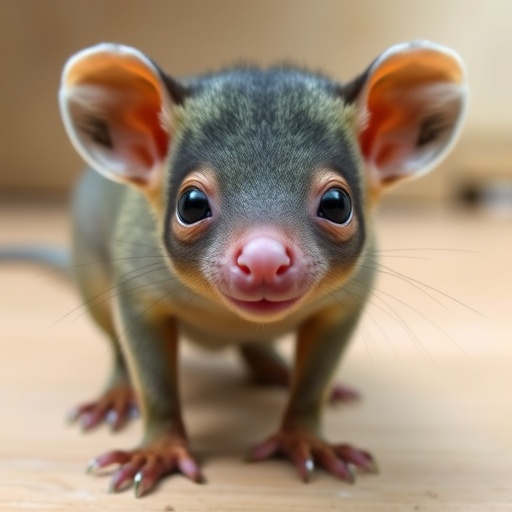In a groundbreaking exploration into mammalian evolution, a team of researchers has unveiled the genetic underpinnings that govern the accelerated facial development in marsupials. Published in the prestigious journal eLife, their study centers on the fat-tailed dunnart (Sminthopsis crassicaudata), a small carnivorous marsupial native to Australia, notable for its remarkably brief 13-day gestation period followed by extended pouch development. This research sheds light on the gene regulatory elements that facilitate the rapid formation of orofacial structures, offering unprecedented insight into the divergent developmental strategies between marsupials and placental mammals.
Marsupials and placental mammals exhibit striking contrasts in their reproductive biology and developmental timelines. While placental mammals undergo prolonged in utero development culminating in the birth of fully formed offspring, marsupials give birth to highly altricial young. These neonates complete much of their growth ex utero, inside a maternal pouch, emphasizing the necessity for advanced orofacial development at birth to enable immediate survival functions such as suckling and sensory navigation. Despite the stark differences, the molecular mechanisms driving these developmental variations have remained largely elusive until now.
A primary focus of the study lies in cis-acting regulatory elements—specific DNA segments that influence the expression of neighboring genes essential for craniofacial development. Previous research had hinted at their critical role in evolutionary developmental biology; however, comparative analyses examining these regulatory landscapes across mammalian lineages at comparable developmental stages were absent. This study fills that gap by combining genomic approaches to contrast marsupial and placental gene regulation intimately linked with facial morphogenesis.
The research team, led by first author Laura Cook, utilized advanced sequencing technologies including ChIP-sequencing (ChIP-seq) and RNA-sequencing (RNA-seq) to scrutinize chromatin modifications and gene expression profiles from the fronto-nasal, mandibular, and maxillary tissues of newborn dunnart pouch young. These tissues represent pivotal regions involved in the formation of the face and jaw. By mapping chromatin marks such as H3K4me3 and H3K27ac, which are indicators of active promoters and enhancers respectively, the researchers elucidated the regulatory topography underlying early craniofacial development in a marsupial context.
A critical component of this research involved juxtaposing the dunnart data against publicly available mouse craniofacial datasets generated by the ENCODE consortium. Mice, representing placental mammals, provided a valuable comparative framework spanning multiple developmental time points. This cross-species comparison revealed that while genes orchestrating facial development are remarkably conserved, their regulatory elements show substantial divergence. Particularly, certain regulatory enhancers exhibited dunnart-specific activity not observed in mice, suggesting evolutionary adaptations reflective of their unique reproductive and developmental exigencies.
Intriguingly, these marsupial-specific regulatory elements cluster near genes implicated in developing the skin and epidermis, muscular systems, and sensory organs. This highlights the evolutionary prioritization of structures critical for survival immediately after birth in the pouch environment. For instance, the development of sensory systems, especially olfactory pathways, is remarkably accelerated in dunnarts, facilitating newborns’ ability to locate and enter the moist, protective shelter of the maternal pouch soon after birth.
The researchers propose that this enhancer-driven regulatory rewiring is a direct contributor to the rapid morphological changes witnessed in marsupial orofacial development. The unique enhancer landscapes in dunnarts not only underscore the plasticity of genetic regulatory mechanisms across mammals but also illuminate how shifts in gene regulation can produce profound developmental and evolutionary consequences.
Co-senior author Irene Gallego Romero emphasizes that the sensory system gene expression findings underscore a critical survival strategy in marsupials. The challenge faced by newborn young to locate their mother’s pouch relies heavily on sharp early sensory development, a stark departure from the in utero maturation processes of placental mammals. This evolutionary innovation epitomizes how gene regulation caters to different ecological and reproductive niches.
Moreover, senior author Andrew Pask reflects on the broader implications of these findings for comparative genomics and developmental biology. By establishing new genomic resources for the fat-tailed dunnart and pinpointing divergent enhancer activity associated with craniofacial growth, this work paves the way for future studies examining enhancer function and mammalian developmental diversity. The study also illustrates the transformative potential of integrating genomic technologies in uncovering the molecular basis of evolutionary adaptations.
Despite the insights gained, the study acknowledges limitations, notably the lack of multiple postnatal developmental stages due to specimen availability constraints. The team aspires to expand these investigations across temporal developmental windows using single-cell and multi-modal genomic technologies to further dissect the nuanced regulatory distinctions between the central nervous system and orofacial tissues in marsupials.
This pioneering endeavor not only elucidates fundamental developmental biology questions but also opens avenues for exploring how gene regulatory evolution shapes mammalian diversity. The intersection of epigenetics, gene expression, and evolutionary developmental biology represented in this study heralds a new era of understanding mammalian ontogeny, with broad implications spanning biology, genetics, and evolutionary science.
As marsupial genomes continue to be charted in finer detail, studies like this one underscore the value of non-traditional model organisms in addressing complex biological phenomena. The refined characterization of enhancer dynamics in dunnarts sets a new benchmark in comparative functional genomics and evolutionary developmental biology, promising to illuminate the genetic architecture underlying life’s diversity.
Subject of Research: Animals
Article Title: Gene regulatory dynamics during craniofacial development in a carnivorous marsupial
News Publication Date: 28-Oct-2025
Web References: https://elifesciences.org/about, https://elifesciences.org/subjects/developmental-biology, https://elifesciences.org/subjects/genetics-genomics
References: DOI 10.7554/eLife.103592.3
Image Credits: Cook et al. (CC BY 4.0)
Keywords: Life sciences, Developmental biology, Genetics, Genomics, Mammals, Marsupials, Evolutionary developmental biology
Tags: accelerated craniofacial development in marsupialsdevelopmental strategies in mammalseLife publication on marsupialsevolutionary biology of marsupialsfat-tailed dunnart genetic studygene regulatory elements in developmentgenetic factors in marsupial growthmarsupial versus placental mammal evolutionmaternal pouch growth in marsupialsmolecular mechanisms of craniofacial growthorofacial structure developmentshort gestation period in marsupials





